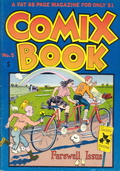comix book

Comix Book
Kitchen Sink (1974-76)
Comix Book was conceived in 1973 when Stan Lee decided he wanted to market underground comics to a broader audience with standard newsstand magazine distribution. He recruited Denis Kitchen from Kitchen Sink Press to edit the magazine and Kitchen in turn recruited many of the luminaries from the underground comic scene to contribute (a handful of artists wanted nothing to do with a Marvel publication). Kitchen was able to lure some creators with a relatively high compensation rate for new work, which Jay Kinney reported to be $100 a page in Young Lust #8.
In order to distribute the mag on mainstream newsstands, Lee needed content that didn’t include the total deviancy of many underground comics, so Kitchen asked that creators not go overboard with depictions of sex and drug use, and there were certain profanities and graphic depictions that were simply forbidden. In return for limiting their creative freedom, Kitchen won some unprecedented concessions from Marvel, including allowing the artists to retain their original art and their long-term copyrights. However, Marvel retained first-publication and collection-publication copyrights, which was a concession that Kitchen had to give up to move the project forward.
These policies were continually in flux as Kitchen and Stan Lee debated them prior to publishing the first issue. There is some evidence that Marvel was using “fine print” to steal away artists’ rights. For example, Jay Lynch received a check for work he did for the first issue in the amount of $40, a check which he never cashed (and he still possesses) because (as stated on the back of the check) by endorsing the check, Marvel would have then owned the trademarks on his characters. Because of this fine print, Lynch didn’t cash the check and was never published in Comix Book. I’m not sure whether every artist had the same fine print on the back fo their checks from Marvel.
The Comix Book experiment ultimately failed, as the magazine never found a large enough audience and newsstand distributors were confused about what to do with this off-the-wall cartoon magazine from family-friendly Marvel. Lee pulled the plug as the third issue hit the stands, but since Kitchen had already orchestrated five issues of content, Lee eventually allowed Kitchen Sink Press to publish the final two issues. Those last two issues are the toughest to find in nice condition, since Kitchen Sink only printed 10,000 copies of each of them while Marvel had printed 200,000 copies of the first three issues.
Derided in some circles, Comix Book is actually pretty good stuff from an all-star line-up of creators, including Spiegelman, Trina, Stiles, Poplaski, Geradts, Cruse, Williamson, Deitch, Pound, Green, Boxell and Kitchen. With those nice page rates and the prospect of more work in the future, the creators produced some of their better work.
Some comic book historians and collectors believe that the historical era of underground comic books truly ended in 1976, when Comix Book and Arcade both published their last issues within a couple months of each other. I believe the era extended to 1980, when Spiegelman’s Raw magazine and other non-conventional comic books began to provide a viable alternative to the underground style. But I don’t argue the fact that ’76 might be the more accurate endpoint. Then again, many argue that underground comics are still being published today with small presses, but that opens a whole different can of worms.





